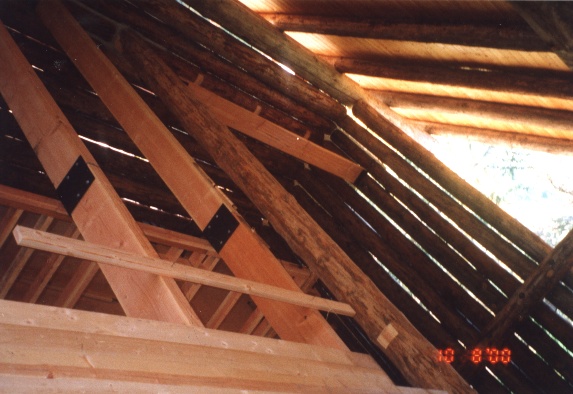
During the summer of 2000, we started out working on the interior of the cabin, setting up the second floor. We added a simple 2x4 frame wall to hold up the middle of the floor. It is the only load bearing interior wall. As seems to happen more often than not in this project, as I was getting ready to build the wall and deciding I really didn't know how to frame a bearing wall, a stranger walked up to look at the cabin and provided us with all the information we needed to do the job. It turned out that he was a retired carpenter and he told us about sleepers and sampson posts and headers. I suppose I could have purchased one of those books on framing but I'm getting a little weird about figuring everything out for myself. Besides, what else would retired carpenters do on their holidays if they couldn't seek out guys like me and pass on their accumulation of knowledge.

To start the process I rented a laser transit. We decided exactly were we wanted the second floor to sit in the cabin and used the transit to provide a level line all around the walls and the central floor beam. We built the central wall and cut a narrow log to use at the end of the wall. It wasn't really necessary to support the central floor beam because the wall itself takes all the weight of the second floor, but it looked pretty. We used brackets from Simpson Stong Tie cut into the log walls to secure the outer edge of the floor. We supported a 2x6 TnG floor on 4x12 beams on 4 foot centers. This not only gives us a properly massive look but plenty of room to fit the stairway between the beams.

We blind nailed the boards to the beams and glued them too so they wouldn't squeek. Blind nailing means driving the nails into the edge of the board over the tongue so that no heads are visible. This will allow us to sand the floor smooth on top and it looks prettier too. It's nice that the kids are getting large enough to help with the tricky bits.
The finished floor here is very rigid but it is porous to liquids. The cracks between the boards make it hard to sweep clean but easy to vacuum. Sounds travels through it easily because we have no sub-floor. All things to keep in mind when deciding to use this style. Since this is a sleeping loft, we don't seem to have any trouble with it at all.